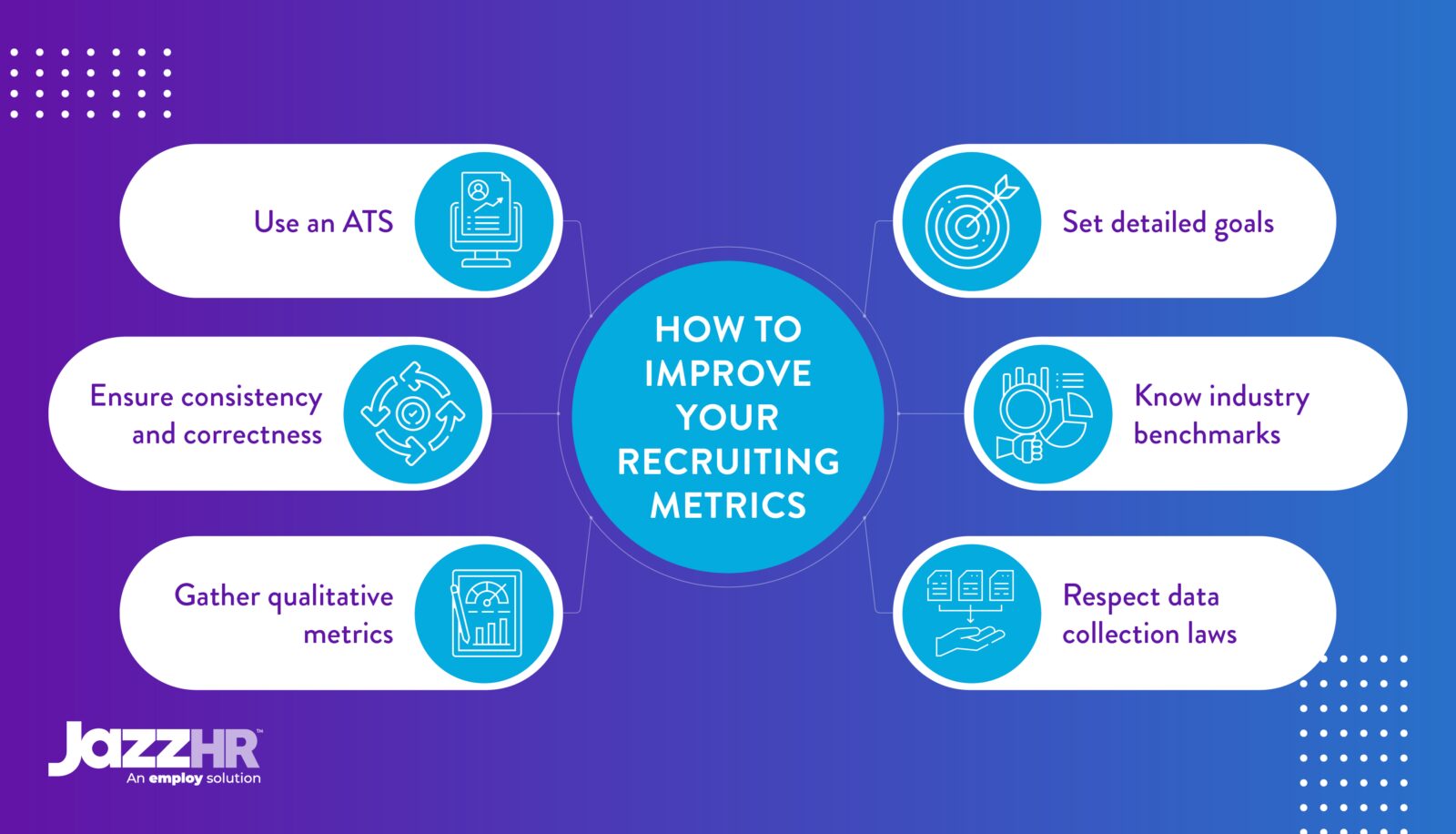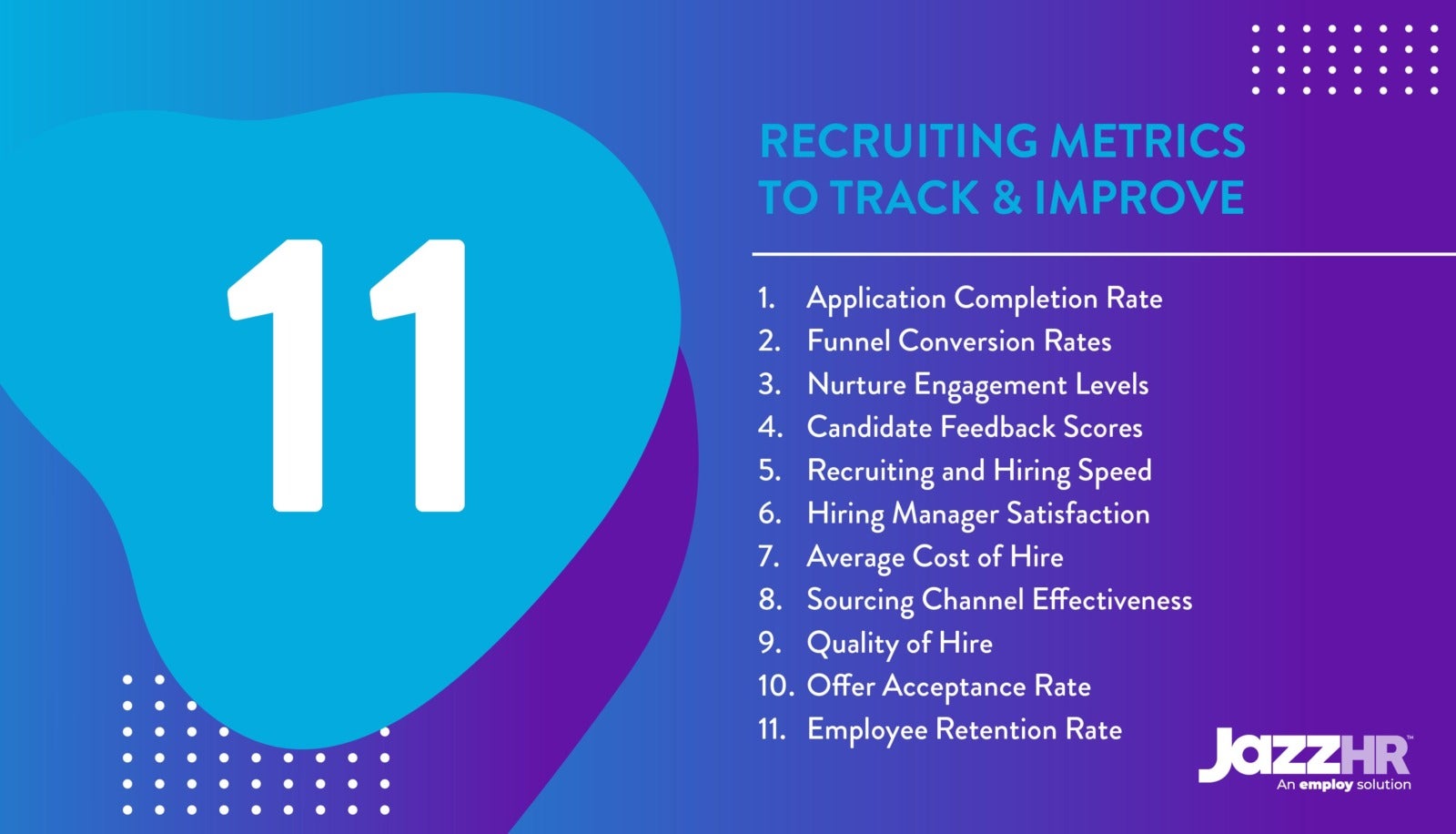
11 Recruiting Metrics for Your Hiring Team to Track
Improving each stage of the recruiting lifecycle, including candidate sourcing, engagement, and conversion, is critical for small-and medium-sized businesses (SMBs) like yours to grow.
But before you begin, you need to identify key data related to your short- and long-term hiring efforts that matter most to your growing business. Even in a smaller company, you must also ensure you have the people, processes, and technology in place to monitor these recruitment and hiring metrics. Let’s review some useful recruiting benchmarks to track and explore helpful tips for collecting data.
- Why Tracking Recruiting Metrics Matters
- How to Improve Your Recruiting Metrics
- 11 Critical Recruiting Metrics to Monitor
Why Tracking Recruiting Metrics Matters
Before examining must-track recruiting metrics, it’s worth understanding the value of monitoring your recruiting and hiring process effectiveness. Specifically, when you know where recruiting bottlenecks exist, you can drive down recruitment costs, streamline the application process, and improve candidate outreach.
No matter how many people you need to add or what your business faces, you should make sure you have data-driven insights to guide your hiring efforts. Complete recruiting metrics enable you to determine whether you’re engaging and onboarding job seekers effectively or if you need to adjust your approach.
It’s important not only for your HR team to track talent acquisition (TA) data regularly — it can also help your business leaders make more informed decisions about adding resources in the company. After all, your leaders want to know which processes are efficient, effective, and contribute to long-term growth, so they can allocate resources accordingly.
Best Practices for Collecting Recruiting Metrics
Now that you understand why you should collect recruiting metrics, you should know some basic ways to simplify your recruitment data collection. Keep these essentials in mind:

- Use an applicant tracking system (ATS). Regardless of your SMB’s size, an ATS like JazzHR can help your company source qualified candidates, provide a positive application experience, and improve your employer brand.
- Set detailed goals. Ensure your team’s goals follow the tried-and-true SMART (specific, measurable, attainable, realistic, and time-bound) framework, so you can easily pinpoint relevant metrics.
- Ensure consistency and correctness. Make sure your collection methods and criteria remain consistent, and regularly audit your data to correct any discrepancies.
- Know industry benchmarks. As you start setting recruiting metrics, research within your industry to see which metrics have worked for similar businesses.
- Gather qualitative metrics. Don’t just focus on the numbers. You can gain valuable, nuanced insights by asking for qualitative data, such as comments about your recruitment process or perceptions of your employer brand.
- Respect data collection laws. Thoroughly research and implement practices that align with data privacy best practices and regulations, such as transparency and security.
As you start collecting, analyzing, and acting on recruiting data, it might take some time to fall into a natural cadence, especially if you’re working with a small team. Regularly audit your processes, so you can bridge any gaps and work better together.
11 Critical Recruiting Metrics to Monitor
Let’s dive into several key recruitment metrics that can give you insight into the strengths and weaknesses of your SMB recruiting efforts.

Application Completion Rate
- Basic definition: The measure of how many candidates started an application and finished it.
- Why it matters: Clunky or complicated application processes that require account setup and log-ins lead to few completions by active job seekers. Conversely, simple, user-friendly application processes that take just a few minutes often lead to higher applicant completion totals.
Funnel Conversion Rates
- Basic definition: Metrics that relay how far prospects advance from stage to stage in your recruiting funnel, such as application to interview rate.
- Why it matters: Tracking funnel-based metrics to see how far the average candidate makes it in the recruitment lifecycle can help you pinpoint areas for improvement in your candidate relationship management approach.
Nurture Engagement Levels
- Basic definition: The open, click, and response rates of candidate nurture messaging.
- Why it matters: Whether you deliver emails, texts, or a mix of both to candidates, you need a mechanism to easily and efficiently analyze your candidate engagement across channels to see which approaches work best and should be used most often.
Candidate Feedback Scores
- Basic definition: Ratings provided by candidates about your recruiting process.
- Why it matters: Compiling feedback from candidates you interviewed for open roles, but ultimately didn’t hire, can give you rich insight into the external perception of your SMB recruitment model. Aside from securing general comments from prospects, it’s equally important to collect specific ratings from candidates, so you can quantify your work — and make the necessary adjustments to provide a better candidate experience over time.
Recruiting and Hiring Speed
- Basic definition: How quickly you move candidates across the recruiting funnel.
- Why it matters: You may not have more than a few total requisitions open at any given time. However, that doesn’t mean you should take a long time to source, nurture, and interview talent. Rather, you need to move with a sense of urgency to steadily drive down your average time to hire and fill. This proves to leaders that you’re making every effort to convert qualified candidates quickly, fill open roles, and keep hiring costs low.
Hiring Manager Satisfaction
- Basic definition: The measure of how satisfied the hiring manager is with the outcomes of the hiring process.
- Why it matters: Feedback is essential for understanding the nuances of your recruiting process. As with candidate feedback, it’s helpful to gather feedback scores and qualitative comments from your hiring team that help you tangibly measure your effectiveness.
Average Cost of Hire
- Basic definition: The measure of how much money your business typically spends on recruiting a single hire.
- Why it matters: Tracking the expenses designated to promote an open position can ensure you don’t waste any resources. Also, this is one of the most important recruiting metrics for SMBs, given the limited budget you might have for paid recruitment marketing activities. Your internal and external recruiting costs can add up quickly if you don’t pay close attention.
Sourcing Channel Effectiveness
- Basic definition: The platforms or channels that yield the most and best new hires.
- Why it matters: Not all sourcing channels provide the same return on investment. That said, you won’t know whether you should continue looking for passive or active prospects on certain channels if you don’t keep tabs on how many leads you secure and how far they advance in your hiring process.
Quality of Hire
- Basic definition: The ratings of new hires by managers several months into the job.
- Why it matters: A high quality of hire indicates an employee you hired is performing well in the job. However, a low-quality hire that has poor reviews and misses target goals can greatly hinder your company’s success.
Offer Acceptance Rate
- Basic definition: The measure of how frequently the offers you extend to applicants are accepted.
- Why it matters: You need to know the rate at which candidates you interview and advance to the offer stage decide to join your business. Direct feedback from potential hires through post-interview candidate experience surveys can reveal why they did or didn’t accept an offer. This can be used to make changes to your recruiting approach for certain roles.
Employee Retention Rate
- Basic definition: The measure of how many of your employees remain at your business over time.
- Why it matters: Employee retention rate is another post-hiring metric that reflects the ROI of your recruitment team’s strategies. A high retention rate indicates members of the workforce you helped hire are satisfied and want to stick around, meaning your recruitment efforts are reaching the right audience.
How to Start Tracking Recruiting Metrics with JazzHR
The foundation of any strong recruiting strategy is your ATS. You need a solution that caters to the unique needs of growing companies like yours and one of the best options available today is JazzHR. With affordable pricing tiers and a comprehensive, intuitive interface, JazzHR makes it simple for SMB teams to track relevant recruiting metrics. To learn more, explore our solution’s capabilities with your free trial today.








